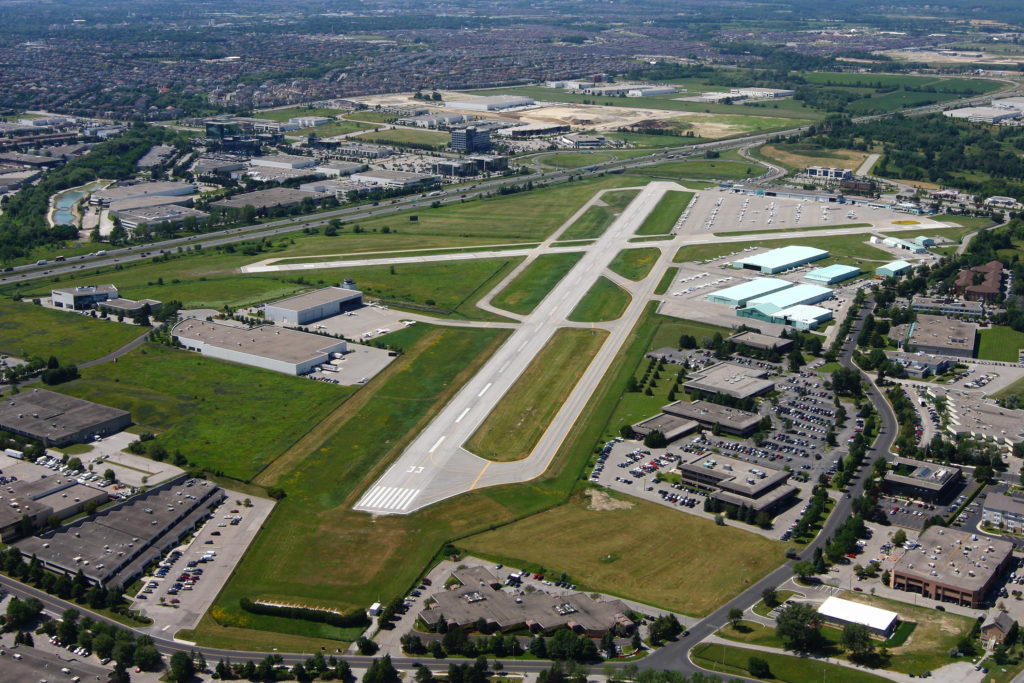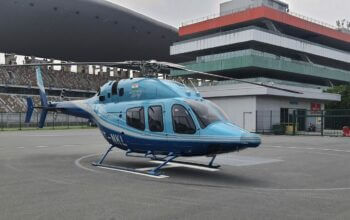Estimated reading time 13 minutes, 22 seconds.

As the long-expected closure of Toronto’s Buttonville Municipal Airport approaches on Nov. 30, 2023, other airports in southern Ontario are preparing to accommodate some of its flight traffic and business opportunities, as well as meet the demand for hangar space.
Buttonville was for many years a beloved general aviation (GA) airport, located in the Toronto suburb of Markham, Ont., and privately owned for more than 40 years before being sold and slated for redevelopment.
It’s expected most of Buttonville’s remaining tenants will relocate to other airports within commuting distance of Toronto after it closes, finalizing a gradual depopulation of airport lands that began more than a decade ago.
The main contenders to absorb Buttonville’s traffic and tenants include Peterborough Airport (YPQ), Oshawa Executive Airport (YOO), and Lake Simcoe Regional Airport (YLS), as well as international airports in Hamilton (YHM) and Waterloo (YKF).
While this presents a major growth opportunity for all suitors, many observers view Buttonville’s closure as a major loss for Canada’s aviation community.
“We don’t want to see airports close, and especially in the Toronto area, where it’s already limited,” said Chris Wood, general manager at Region of Waterloo International Airport and president of the Airport Management Council of Ontario (AMCO).
“We lost Downsview and now Buttonville . . . so we’re already very limited, especially on the east side of Toronto. It’s not fantastic news, but I completely understand it’s a business decision, and it’s been in the works for a long time.”
Long Time Coming
Several Ontario airports began planning for Buttonville’s closure more than a decade ago, after its long-time owners, the Sifton family, announced plans to redevelop the property in 2009.
In 2010, the mammoth real estate firm Cadillac Fairview and its developer partners entered into an agreement to purchase the land. Since then, the airport has operated under a land lease with Cadillac Fairview, and the lease has “reached its natural expiry,” said Derek Sifton in a letter addressed to the airport’s staff and tenants, obtained by CityNews.
Although plans have shifted over time, in July 2023 CBC reported that the latest vision is to transform the property into an “entirely industrial complex,” rather than the initial plan for housing, office space, and commercial properties.
There has been a steady stream of tenant exits from Buttonville since 2010, including the high-profile relocation of the Seneca College Aviation Campus to Peterborough Airport in 2014.
“Seneca is a valued tenant at YPQ,” said Kyle Bruce, manager of airport administration at the City of Peterborough. “The program supports local business and contributes to the social well-being of the community.”
Peterborough saw its gross domestic product grow by 120 per cent between 2009 and 2022, partly due to Seneca’s presence in the community, contributing an estimated $13 million in 2014. Seneca also makes up between 30 and 40 per cent of the Peterborough Airport’s annual flight volume, which ranges from 40,000 to 50,000 aircraft movements, said Bruce.
Seneca’s relocation also prompted a series of infrastructure improvements at Peterborough, including a 1,000-foot extension of the primary taxiway, the creation of a new 2,000-foot crosswind runway, and a parallel taxiway.
Peterborough has been in talks with other Buttonville tenants, but Bruce wouldn’t provide specifics and declined to say if any have made firm commitments to relocate to YPQ.

“We’re fully prepared to accommodate increased demand for new operators and development, and have contingency plans,” he said. “Our team has been fostering collaboration between businesses, airport tenants, and airport users, and has employed a mix of target marketing strategies to promote YPQ as an alternate location to call home.”
Positioned for Growth
At Oshawa Executive Airport, about 60 kilometres northeast of midtown Toronto, several former Buttonville tenants have arrived since 2010, including Aviation Unlimited — Canada’s exclusive distributor for Piper Aircraft, Daher Kodiak, the Mahindra Aerospace Airvan, and Diamond Aircraft.
It’s expected Aviation Unlimited will also move its maintenance facility to Oshawa after Buttonville’s closure, joining the sales office — along with York Regional Police, several corporate aircraft, and general aviation hobbyists.
“We put a model in place here in Oshawa to really focus on corporate and general aviation,” said Stephen Wilcox, airport manager. He noted Oshawa has grown from about 80 aircraft to more than 300 and from 40,000 square feet of hangar space to more than 400,000 square feet since 2010.
“That’s not all Buttonville,” said Wilcox. “That’s reflective of simply the growth we’re seeing in the industry along with growth in Oshawa and Durham Region.
“You go to just about every airport and they’re all putting up hangars and people are getting airplanes. So it’s a good time in aviation.”
Oshawa’s expansion includes a new 30,000-square-foot hangar for another major Buttonville tenant, though Wilcox declined to identify the company. As other Buttonville-based aircraft owners seek a new home for their aircraft, he said Oshawa is trying to accommodate them as best it can.
“We have lots of capacity,” said Wilcox. “It’s really when we start talking about hangar space. Right now, today, we don’t have enough hangar space to accommodate all the aircraft that wish to come.”
Oshawa already hosts two flight schools, and Wilcox said it cannot accommodate additional flight school traffic. And while a small increase in GA flight volume is expected after Nov. 30, he estimated it would be in the range of 1,000 additional movements per year.
“It’s not a material change in capacity, which is good for us,” said Wilcox. “We’re very active now.”
Lake Simcoe Regional Airport (LSRA) in Barrie recently declined a relocation request from a flight school at Buttonville, according to Basil Clarke, warden of the County of Simcoe. Simcoe’s municipal council is the majority shareholder of LSRA.
“This decision was based, among other considerations, on capacity concerns related to strong and growing commercial aviation use and tenant base,” Clarke said in a statement to Skies.
“The County and the LSRA Board is very supportive of aviation training programs and already leases space to an existing flight training school at the LSRA. However, we feel that a second flight school at LSRA would create a very dynamic, complex air traffic environment if flight training at the airport within uncontrolled airspace were to increase significantly.”
Meanwhile, the Million Air fixed-base operation (FBO) at Buttonville said it has “no plans to expand into southern Ontario at the time, but are open to new opportunities.
“We have some new locations in the U.S., and Million Air Vancouver will eventually be undergoing a remodel, but no news at this time,” said the company’s chief brand officer, Allison Woolsey, in a statement.
Personal Connections
After an initial flurry of relocated GA pilots a decade ago, Region of Waterloo International Airport in Breslau, Ont., saw a prolonged dip in inquiries while it focused on growing its commercial airline business.
And while there has been a significant uptick over the last few months, general manager Chris Wood doesn’t anticipate a huge surge in flight volume when Buttonville closes.

“We’ve been getting a lot of phone calls, and we have nine hangars currently slated to be built next year,” he said. “But I don’t think we’re seeing a tremendous change here right now because of Buttonville.”
Waterloo is about 100 km southwest of Toronto — at least a 90-minute drive, depending on traffic — which makes it a difficult sell to private pilots.
“We will never abandon the GA side of it,” said Wood. “But we think we can do it all. We’ve been successful sort of growing those [airline businesses] while continuing to be the largest and busiest GA airport in Ontario, which we’re very proud of.”
As a private pilot himself, Wood has flown at Buttonville and appreciates the personal connections many Ontario pilots feel toward that facility.
“A lot of people learned to fly there, and maybe had their first job there,” he said. “I think it could be a sad day for those people, for sure.”
While Buttonville will permanently close on Nov. 30, runway decommissioning has already begun. Work started on the smaller of the two runways (21/03) on Nov. 20, and runway 15/33 is expected to close shortly after. As such, operators are being encouraged to check NOTAMs before heading to YKZ.
The airport said in a statement that it will accept and service aircraft until it is no longer an option.









Buttonville Airport, which began as a simple grass strip in a farmer’s field in the 50s, has been, over the years, incredible, but sadly Nov. 30 marks its end.
At Buttonville Airport in July of 1980, I took my first Familiarization Flight at a cost of $20. I was hooked! Very soon afterwards, I signed up for the Private Pilot course, obtaining my license 1981, following which I continued on and enrolled in the Commercial Pilots License course, and completed that in 1983, adding a Multi-Engine Instrument Rating course which I completed in 1984. Shortly afterwards, I was hired to fly as a charter pilot with Toronto Airways at Buttonville, where I was until 1988.
Buttonville Airport was my roots in aviation, paving the path which then led me to fly for Ontario Express/Canadian Partner, and then on to Canadian Airlines International. In 2001, Canadian Airlines International merged with Air Canada, where I remained until retirement in 2023.
It was from Buttonville Airport’s pilot training courses that many of my colleagues also found their way to fly for commuter and international carriers, and for this I am very grateful.
Heather and Michael Sifton had the vision to expand a simple grass strip on a farm into a wonderful private airport facility all those decades ago, and it turned out to be a gem for any aviation enthusiast. Many of us in the industry, be it professionally or privately, currently flying or retired, will miss Buttonville Airport and all the services it had to offer.
For myself I offer a huge thanks to the Sifton family for making my personal childhood dreams come true, and I am sure I also speak on behalf of many, many others.
Sincerely,
Robert Cohen